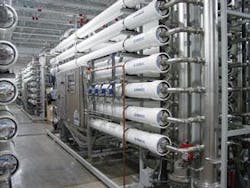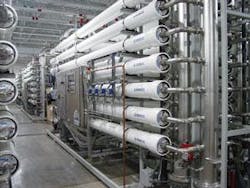Minneapolis’ new UF plant
Mark Feinberg, Madalyn Epple
GE ultrafiltration technology with Norit membranes prevent future outbreaks of Cryptosporidium and help the city comply with stringent water quality regulations.
In September 2005, the City of Minneapolis opened its new Columbia Heights water filtration plant, the world’s largest potable ultrafiltration (UF) plant that uses technology from GE Water & Process Technologies to provide up to 78 million gallons per day (mgd) of potable water to more than 500,000 residents.
Safety concerns and stringent regulatory standards are causing cities around the world to find ways to safeguard water from harmful contaminants, according to George Oliver, chief executive officer of GE Water & Process Technologies. “UF solutions aid cities like Minneapolis in removing unsafe substances from water, so that they can decrease their chance of an incident, like the Milwaukee Cryptosporidium outbreak,” he added.
In 1993, the city of Milwaukee, Wisconsin experienced an outbreak of Cryptosporidium, a waterborne protozoa that is harmful to humans, and if ingested, can cause fever, weight loss, dehydration, vomiting and death. The 1993 outbreak claimed the lives of more than 100 Milwaukee residents. This outbreak prompted the Minneapolis Water Works (MWW) to examine current and future risks posed to the water supply, as well as the possible solutions that would help safeguard the city’s water.
“When we began this project, we knew we needed a system that would remove pathogens from the water supply,” said Shahin Rezania, interim director of the Water Treatment and Distribution Service in the city of Minneapolis. “The removal of Cryptosporidium and Giardia from our potable water supply was very important. In addition, we were seeking a technology that would be able to help us comply with future regulations in the water supply industry.”
In 2000, after thoroughly researching the available technologies, Minneapolis Water Works, with its engineering Peer Review Panel and Citizens Advisory Committee, selected membrane ultrafiltration and invited GE Water & Process Technologies to participate in the bidding and piloting process. The project sought an organization to provide the equipment and technology necessary to safeguard the water supply that was filtered at its Columbia Heights plant in Minneapolis. The technology also had to operate in conjunction with an existing softening and pretreatment system, which has served the city for more than 60 years.
Photo by GE Water & Process Technologies
“In the project development process, the city considered several technologies including microfiltration (MF) and UF,” said Madalyn Epple, GE’s municipal sales manager of the Midwest Region. “With input from the Citizens Advisory Panel and the Peer Review Panel, they concluded that virus removal and a barrier for particulate matter and pathogens, such as Cryptosporidium, were top priorities. UF provided this capability, and because they didn’t need dissolved solid removal, this technology was ideal for use at Columbia Heights.” Upon completion of the bidding and piloting process, Minneapolis awarded GE the contract to provide the UF membrane filtration equipment for the plant.
GE provided Minneapolis Water Works with a UF system consisting of four trains with a total of 40 UF units, 36 of which are operating today. GE’s UF solution is a pressure-driven technology that provides a physical barrier to pathogens and is commonly used to remove suspended solids, bacteria, microorganisms and viruses in potable water production. The systems use hollow fiber UF membranes, which provide the ability for system integrity testing. The membrane systems have two modes of operation: a production mode where feed is forced through the fibers to make product, and a backwash mode in which some of the filtrate is forced back through the membranes to remove any solids.
The State of Minnesota certified the UF solution offered by GE for removal rate credits of 99.99 percent of Cryptosporidium and Giardia lamblia, and 99.99 percent removal of waterborne viruses. Additionally, UF provides consistent, superior water quality regardless of feed quality variations; dead-end operation resulting in low energy consumption; proven membrane life and small system footprints and compact arrangements.
“While we were implementing the UF system, we found we had to continue to pilot during the entire process,” said Mark Feinberg, GE’s project manager. “Because the water in the Mississippi River changes with each season, we had to plan for many different scenarios. We were able to adapt our systems to accommodate this challenge while keeping the water quality consistent.”
The Columbia Heights plant employs a complementary system that removes hazardous waterborne microorganisms and contaminants. Testing has shown consistent water integrity and compliance with Minneapolis Water Works requirements.
The Columbia Heights facility will be capable of providing up to 72 million gallons of potable water per day, making it the largest potable UF plant in North America. The only UF plant in the world that is larger is another GE plant in Kuwait, which provides up to 100 million gallons per day.
GE is also working with the Minneapolis Water Works on the Columbia Heights’ sister plant in Fridley, Minnesota, which will be capable of providing up to 95 million gallons of potable water per day. In addition, the City of Mankata, Minnesota, awarded a contract to GE to provide UF technology for a water treatment plant upgrade project. The Mankato plant, which will provide 12 million gallons per day of potable water to city residents, is expected to be online in April 2007.
Author’s Note
Both authors, Project Manager Mark Feinberg and Madalyn Epple, Municipal Sales Manager of the Midwest Region, work for GE Water & Process Technologies.

